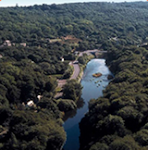Water was a major theme of the day when we visited Smalley Hill.
1) It was raining when we arrived
2) There are several pools on the site
3) It rained whilst we were on site
4) There are numerous boggy areas
5) There are hundreds of ruts in the ground where water accumulates
6) After a brief interlude of sun it poured down signalling our retreat to our homes.
Fortunately we had been warned about the water underfoot and advised to wear wellingtons. That was the best advice I have had in ages.
Our start was delayed as my directions to the meet point were not up to scratch and only I could find it (being helped by knowing where it was). But, eventually everyone arrived. After the initial greetings we set off, but not before investigating a box bush where we found the "box" anthocorid bug Anthocoris butleri.
On site we first made our way to the shelter of a narrow plantation where we investigated the gorse and kept out of the cool stiff breeze. A bug was beaten out of a scot's pine
 |
| Photograph: David Williams |
This is Gastrodes grossipes a species that feeds on the cones of this tree.
And a very wet area that seemed to stretch to the far side.
Curiously we found frog spawn in a tree!!
 |
| Photograph: Jim Cresswell |
As you can see from the above photograph I managed to capture the owl box but the kestrel was long gone!
Invertebrates were very hard to find. We tried looking, we tried beating, we tried sweeping and we tried vacuum sampling but not much was poking its head above ground. However, we were not discouraged - we looked for somewhere to lunch.
On the way we came across a large patch of Cladonia lichens
Close by we saw a hopper. However, it defied all attempts to pot or even sweep it so was left in peace and unidentified.
We lunched in the lee of a large gorse bush. The sun came out and spread a little warmth.
Lunch over we all made our way to a pussy willow that was in flower to see what the sun had brought out. There were several bees nectaring on the tree, most of them near the top, but we managed to identify four - honey bee (Apis mellifera), tree bumblebee (Bombus hypnorum), early bumble bee (Bombus pratorum) and buff-tailed bumble bee (Bombus terrestris). As we were about to leave a hoverfly was seen on a catkin. This was Eristalis intricarius and it was content to pose for a while enjoying the warmth of a hand.
The rain returned. This was one shower too many and we decided to return home.
My thanks to the Shropshire Wildlife Trust for permission to do what we enjoy doing, to Veolia for allowing us to park on its property and to David Williams and Jim Cresswell for the photograph.


























































